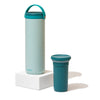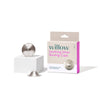Of all the symptoms of the postpartum period, constipation is perhaps the most common. An estimated 72 percent of pregnant people experience it at some point over the course of their pregnancies1, and it is also common in the post-pregnancy period—especially in the days after delivery.
What is Postpartum Constipation?
Constipation is defined as having fewer than three bowel movements a week, and it can involve significant straining with each bowel movement as a result of firm stools.
Why Does Postpartum Constipation Happen?
Your body is recovering from labor and the many shifts it made to accommodate your growing baby. The circumstances of your delivery, like whether you had an episiotomy or tearing, can also play a role in the severity of constipation. The pain associated with the recovery from a vaginal delivery alone may be enough to make you consciously or subconsciously fear having a bowel movement. Other contributing factors include postpartum hemorrhoids, pain medications, and swollen veins that can crop up in and around your anus as a result of pregnancy or pushing during delivery.
Constipation is most common during the first few hours to days after giving birth. If you are still in a hospital setting, nursing staff can provide suggestions to help alleviate your symptoms.
While anyone can experience constipation, it is common among those who deliver both vaginally and by C-section.
How to Heal Postpartum Constipation
There are many remedies that may help alleviate the discomfort:
-
Drink plenty of fluids: It’s easy to become dehydrated during and after giving birth. Your body loses a lot of liquid from sweating, and your focus shifts from caring for your body to caring for your baby’s. Drink enough fluids until your urine is pale yellow, a sign that your body is sufficiently hydrated.
-
Eat fiber-rich foods: Fiber is a nutrient that helps move food and waste through your body. It’s important to get 25 grams of fiber per day.2 You can find fiber in plenty of foods, including whole grains, fruit (in the skin or peel), nuts, and seeds.
-
Get moving: Movement works wonders for constipation. You may not be in the condition to move much, but getting up and walking around with the help of nursing staff, or family and friends, will help get things moving and alleviate constipation.
-
Take stool softeners: Over-the-counter stool softeners can be taken preventatively for the first two weeks after delivery, until you are having regular, easy bowel movements.
-
Colace (docusate) can be taken twice a day. It works to soften the stool, making it easier to pass.
-
Take a laxative: Over-the-counter laxatives can be taken daily until you are out of the immediate postpartum period.
-
Senna is a stimulant laxative that encourages intestinal motility and more regular bowel movements.
-
MiraLax is an osmotic laxative, meaning that it draws water into the colon to soften the stool and stimulate the colon to contract for easier bowel movements.
-
Milk of magnesia is a saline laxative that draws water to the bowel from nearby tissue to moisten and soften stools, and help increase bowel activity.
-
Suppositories and enemas can also help, so long as you haven’t been told to avoid inserting anything rectally, i.e. if you’ve had a fourth-degree tear.
-
-
Try perianal pressure/splinting: If you don’t have stitches for a vaginal laceration, you can reduce straining during bowel movements by inserting a lubricated finger or tampon into your vagina and pressing back against your anus to help move the stool. You can also try a toilet stool and spend only the amount of time needed on the toilet; if you need a little time to yourself, use it sitting in the bathroom and not on the toilet.
-
Perform perineal massage and self-acupressure: This technique involves applying pressure to your perineum to help manually break up the stool. After urinating, wash your hands and then use your middle and index fingers to press on your perineum, pushing toward the back of your body in repeated pulses until you feel like you are about to defecate. (You can place a pad between your fingers and perineal for extra protection.)
Get nourished with Chiyo
Get nourished with Chiyo
Chiyo’s meal programs are specifically designed to meet moms where they are — whether that’s trying to conceive or postpartum. Use the code WILLOW30 to get $30 off your first order.
When to get help
It is common to go a few days after delivery without a bowel movement. Your health care provider may be able to suggest a laxative or stool softener to speed things along.
Call your doctor if:
You haven’t had a bowel movement in more than three days
You are experiencing severe abdominal pain
You have blood in your stool
Learn More With Willow
Being a new mama can be overwhelming, pregnancy is an exhausting process, let alone trying to navigate all of the physical changes your body experiences! Looking for more resources? Visit the Willow blog to find insights and advice from real experts. You've got this!


















